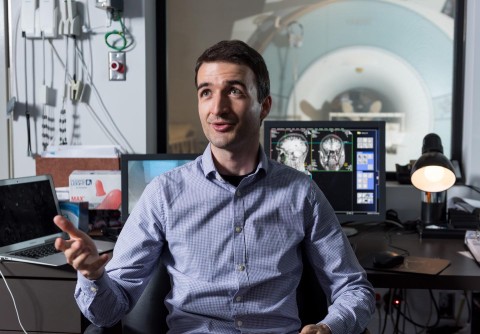
An assistant professor in the School of Psychology has been awarded $2.2 million in National Institutes of Health (NIH) grants for two research proposals that could provide scientists more guidance for navigating the brain’s landscape.
Dobromir Rahnev’s NIH research will focus on the parts of the brain that are involved in decision making, and will also study how a promising treatment for neuropsychiatric disorders could be made more effective.
“I am very excited to receive these grants as they will allow us to perform important research on metacognition and on brain processing more generally,” Rahnev says.
“Uncovering the Architecture of Metacognition” will focus on the phenomenon of hierarchical noise architecture, and how it effects the ability to reflect on, and evaluate, one’s behavior. Problems with metacognition have been potentially linked to a number of psychiatric disorders, including schizophrenia, depression, and obsessive compulsive disorder (OCD). People who suffer brain lesions may have metacognition issues, and it may even be tied to substance abuse.
Rahnev says learning more about hierarchical noise architecture will be important. “Consider decision making as a two-step process,” he says. “First, one makes a decision that can be about anything. Second, one needs to make a metacognitive judgment about how likely the original decision is to be correct. The central tenet of our proposal is that the metacognitive decision inherits the noise, biases, and inefficiencies of the first decision, and is additionally corrupted by what we call metacognitive noise. This noise can come from multiple sources, and this is part of what we plan to investigate.”
The second NIH research proposal, “Improving Behavior with TMS: A Concurrent TMS-fMRI Approach”, focuses on transcranial magnetic stimulation (TMS), which is a non-invasive procedure using magnetic fields to stimulate nerve cells in the brain. It has shown promise in treating major neuropsychological conditions such as Alzheimer’s disease, and it has been approved by the Food and Drug Administration for treatment of depression. But TMS’ effects can vary from patient to patient.
By combining TMS with functional magnetic resonance imaging (fMRI), “we hope that our research will help improve its effectiveness, but we won’t directly test patients,” Rahnev says. “Instead, our proposal is focused on understanding how TMS affects brain function, and whether its effects can be predicted by the pre-existing brain state. TMS is usually applied by itself, which makes this question difficult to address.”
Hence the proposal to have TMS applied while a patient is inside an MRI scanner engaging in cognitive tasks. “This will allow us to determine what features of brain activity predict when TMS is helpful or detrimental to performance. Based on these insights, we hope to develop methods that could be used to improve the usefulness of TMS in both basic and clinical research though this will need to be done in a follow-up project.”
Rahnev writes about his research combining TMS and fMRI on his website for his Computational Cognitive Neuroscience research group. “We use a variety of methods such as functional magnetic resonance imaging, transcranial magnetic stimulation, psychophysics, and computational modeling. We also strongly support open science and share the data and code for all our papers.”
RELATED LINKS
- Rahnev Receives Office of Naval Research Young Investigator Award
- I Saw That. Brain Mechanisms Create Confidence About Things Seen
- B.S. in Neuroscience Takes Off at Georgia Tech
- Out of Mind, Out of Sight
